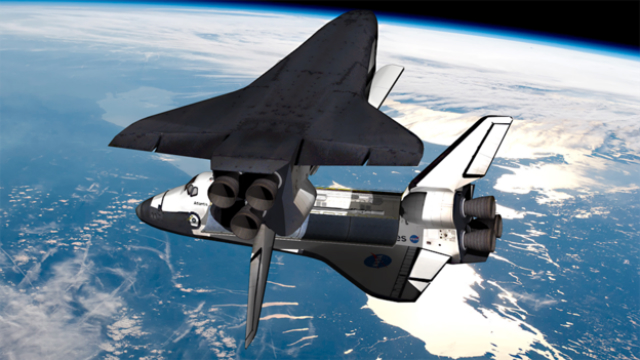The Space Shuttle Columbia disaster, which killed all seven astronauts on board, effectively ended the US Shuttle Program. Now, a former engineer is proposing a radical (albeit hypothetical) solution to rescuing stranded astronauts that was inspired by the disaster.
The plan proposed by David Baker is no less ambitious than the one that brought Apollo 13’s crew safely back to Earth. Conceived originally by the Columbia Accident Investigation Board and further developed as part of his research for an upcoming lecture at the British Interplanetary Society, the rescue plan would essentially involve launching and docking a second shuttle, the Atlantis, with the disabled first — something never before attempted. However, for the plan to have worked during the Columbia crisis, mission control would have needed to know exactly how bad the damage was from the start.
As the BBC explains, the hypothetical rescue would go something like this:
On day two of the STS-107 mission, the Columbia astronauts are alerted to the danger. Systems are powered down, exercise is restricted to reduce the production of carbon dioxide and food is rationed. Meanwhile, with the world’s media looking on, Atlantis is rushed towards launch. With just hours to spare, and with carbon dioxide levels on Columbia rising to dangerous levels, the second shuttle blasts into orbit with four crew on board.
Once the spacecraft reaches the stricken craft, the Atlantis pilot positions his shuttle above and at right angles to Columbia to avoid the tails hitting each other. “You need to keep about 20ft feet (6m) away for two days,” says Baker. “Two crew members on board each shuttle would do that.” This would have involved exceptional piloting skills. With each spacecraft spinning around the Earth at seven kilometres per second, a small lapse in concentration could have resulted in catastrophe.
Meanwhile the other two Atlantis astronauts begin the first of many spacewalks, delivering lithium hydroxide canisters to the Columbia crew to bring down life-threatening carbon dioxide levels. They also deliver two spacesuits. Next, the Atlantis astronauts position an extendable pole between the two Shuttles. This will be used to guide the Columbia crew across the handful of metres between the two spaceplanes.
With everything in place, two at a time, Columbia astronauts are helped out of the airlock, across the gap and into the Atlantis airlock. “They would have then had to take their suits off and repeat the process again to husband out the next two,” Baker explains.
Forty-eight hours later — after all, space suits take nearly an hour to get on and off — when the last crew member is safely aboard the Atlantis, mission control would take over guidance of the Columbia and chuck it into the atmosphere to burn up. The 11 astronauts now aboard the Atlantis would then have their own wild ride to endure during the unprecedented rescue return. [BBC]
